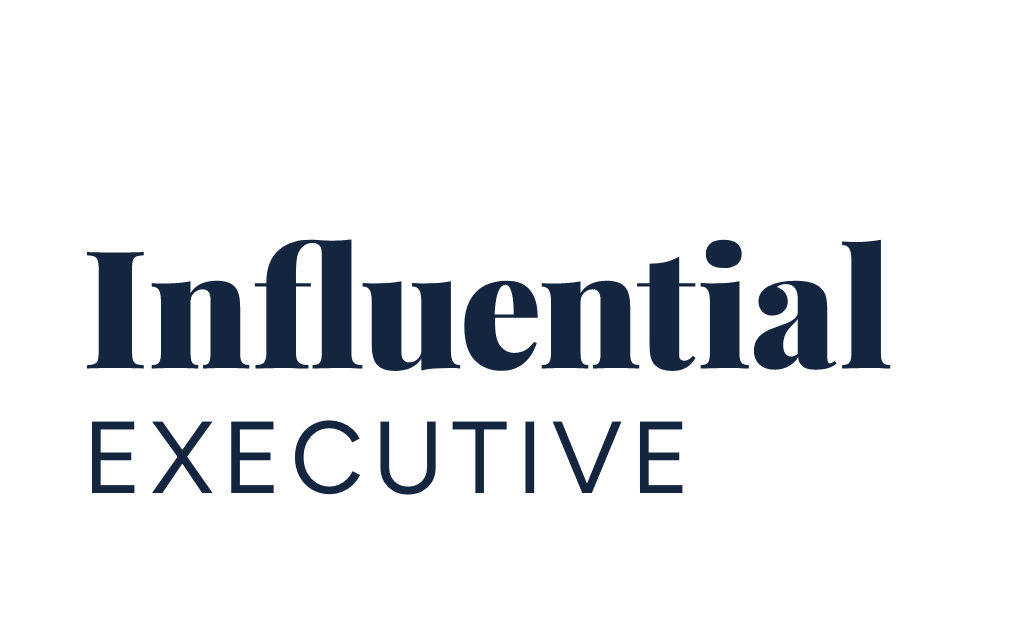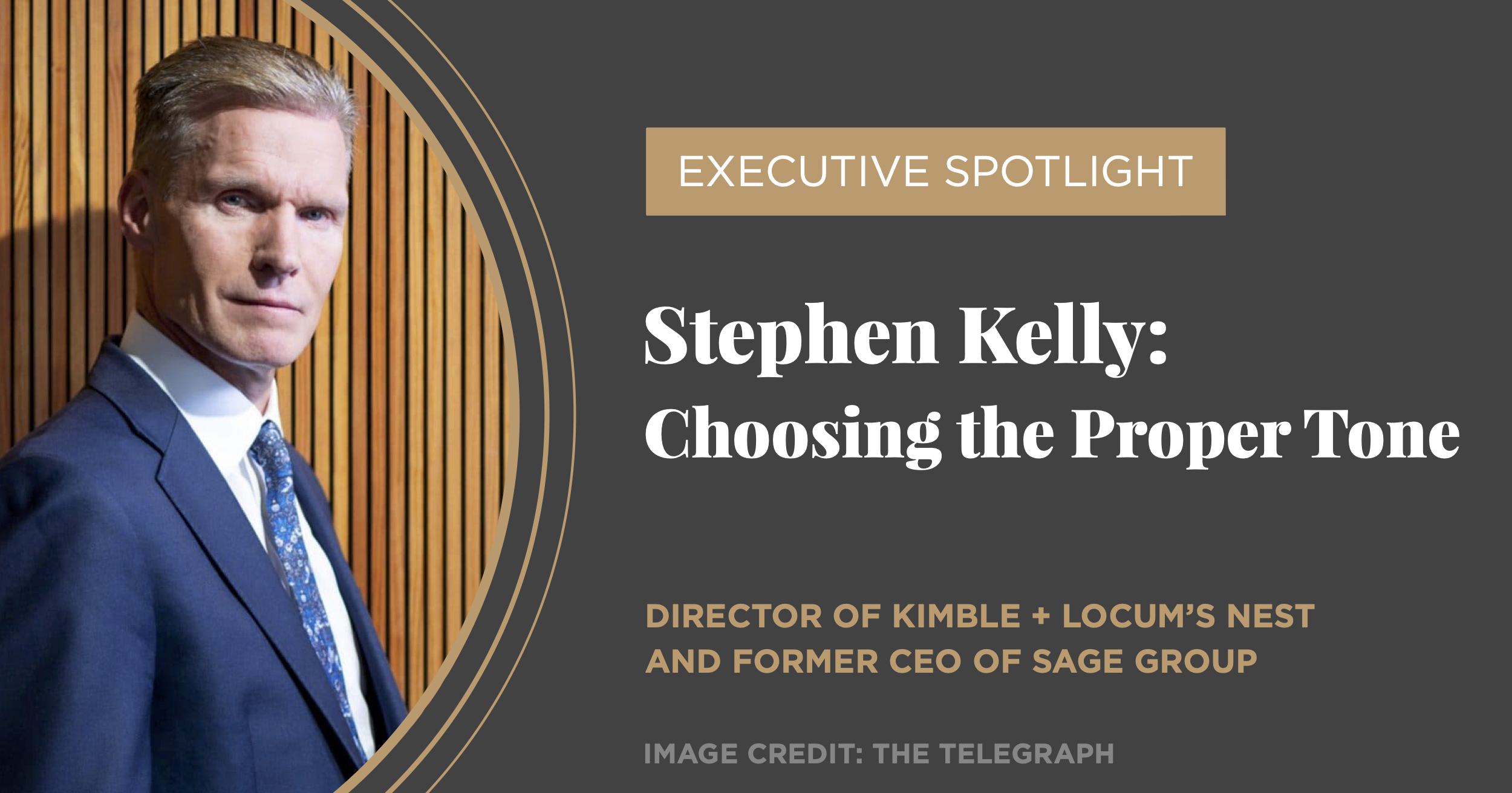Stephen Kelly, the current Director of Kimble Apps (a professional services automation software) and Locum’s Nest (an app connecting doctors to locum work in hospitals) has many titles under his belt. As the former CEO of Sage Group, he was also previously the CEO of Micro Focus and Chordiant Software, and worked for four years as COO for the U.K. Government. Though his various positions have spanned across different industries, Kelly still manages to maintain a consistent presence on multiple social media platforms.
In this article, we will be analyzing Kelly’s LinkedIn and Twitter platforms, which have 13,000 followers and 25,000 followers, respectively. We will be looking at the way he utilizes his content and tone on each respective platform, and how these strategies adhere to best practices when it comes to reaching target audiences. Executives can draw inspiration from the way Kelly adjusts his content accordingly, which helps him reach a larger audience than it would if he used the same language and content across the board.
LinkedIn: Professional
Kelly displays a dichotomy in tone when comparing his LinkedIn and Twitter accounts. On Twitter he utilizes more casual language, while on LinkedIn, his content is presented with a more formal tone and is mostly geared more towards other professionals, executives, and leaders. With the primary demographic of LinkedIn being users aged 18 – 49, and since LinkedIn is an employment-oriented platform, utilizing more business-minded content is ideal.
Kelly also tends to use language that is more industry-specific in his LinkedIn posts, using jargon that the average user outside the industry may not necessarily understand. While this may seem inaccessible at first glance, it is important for executives to remember that LinkedIn is a professional networking resource. Therefore, many who are looking at executives’ LinkedIn content are likely looking for posts that are tailored for people in the industry. Given that LinkedIn is a professional database, his audience on LinkedIn is also likely to be other professionals, executives, and leaders in similar or adjacent industries. It is because of this reason that Kelly’s content reflects an understanding of his audience on this particular platform.
In Kelly’s recent feed, all of his posts revolve around the COVID-19 pandemic. In his dedication to staying up-to-date with the latest news, this contributes to his authenticity as a leader who is aware of current events, making him more relatable to users. Given current events, users expect leaders to discuss the COVID-19 pandemic. Executives who omit or ignore global trending news can appear out of touch compared to those who are posting about it. Thus, Kelly’s incorporation of time-sensitive coronavirus news contributes to his legitimacy as a leader. Executives should bear in mind that this does not mean brand awareness needs to be compromised. On the contrary, Kelly is sure to incorporate his personal branding even into his coronavirus-related posts. For example, he customizes his content to the topic while still linking to his own blog posts (which helps to promote his own content), or including graphics that include his face and brand.
Kelly also frequently makes use of videos on his LinkedIn page. This is an important feature to utilize, as video content has been found to be prioritized by the LinkedIn algorithm, which means that video content is more likely to show up at the top of users’ feeds. In the example below, Kelly promotes one of his recent blog posts that discusses the inner workings of “forensic expense control,” giving a brief summary of the topic. Kelly’s more casual appearance and set-up (he is recording through his phone camera, not through a professional set-up) makes his content more accessible to users, as the video is not scripted and thus helps him to come across as a more personable, authentic executive.
The content Kelly shares on LinkedIn is a mixture of third-party articles and original content. In posting original content, Kelly further distinguishes himself from other leaders by having posts unique to his feed. In sharing third-party articles, this helps to show that he is an executive who is dedicated to growing as a leader by referencing other executives. Kelly also includes appropriate tags when he reposts content from other brands and executives. Engagement can increase exponentially through tagging other profiles as this helps to boost interactions and impressions.
Twitter: Personal
On a whole, Kelly uses his Twitter feed to share more personal content than he does on his LinkedIn page.
On his Twitter bio, Kelly uses all of his professional positions, even his former ones, in his title. The bio description is most noticeable since it appears at the top of a user’s profile, and is thus one of the first features that appears when clicking onto the page. He also makes sure to tag the businesses he is currently a part of (Locum’s Nest and Kimble App). We recommend executives tag their company in their bios if it has its own social media page as this will help strengthen the connection between an executive and their business.
When it comes to Kelly’s content, he utilizes many functions Twitter has to offer: personal videos, original Tweets, and retweets. Kelly also uses hashtags, as well as proper tags when retweeting or mentioning other brands or people in his copy. When he does include posts that promote his own services or projects, he tends to take on a more personal tone.
Thanks for inviting me to join @Tweetinggoddess in Win Business clinic – great questions and conversation from #Entrepreneurs #Entrepreneurship #IrelandLockdown #coronavirus #Entrepreneur https://t.co/VRfK8mmJBa
— Stephen Kelly (@SKellyCEO) April 7, 2020
Kelly’s content also reflects a balanced mix of original thoughts and retweets. That he does not solely post original Tweets shows he is well connected to events outside of himself, and that it is not solely third-party content allows his own voice to be showcased. Posting third-party content also allows for a larger audience reach, as it opens up the possibility for reciprocal content sharing (ie. the resource whose content one shares may be open to returning the favor, thus increasing traffic to one’s own page). As mentioned earlier, his content is also significantly more personal on Twitter than it is on his LinkedIn, as he often shares photos and videos of his personal life, and also shares articles he finds personally interesting or relevant, which may not always be related to his industry.
Is it me or do you think #easteregg hunts 🐰 are fun even when you are in your twenties – also magic for Dads who never grow up? Cryptic clues and chocolate eggs 🥚 🐣 to find #HappyEaster #BeSafe #StayHome #BeKindToEachOther pic.twitter.com/3kOjhFt9b0
— Stephen Kelly (@SKellyCEO) April 12, 2020
Similarly to his LinkedIn, though, Kelly has recently been posting coronavirus-related information. However, Kelly uses his Twitter platform to share more general news on the topic, whereas his LinkedIn content is more tied to the pandemic’s impact on businesses and the economy. Whether it is uplifting content or content more specific to his brand, this shows that he is dedicated to informing users on relevant and reputable news. In his particular case, this is reflected directly in his brand’s messaging as well, since Locum’s Nest is an app related to the healthcare industry. As an executive, even if one’s business is not directly connected or impacted by the pandemic, incorporating timely news into your content is important, as consumers are looking to brands that are empathetic to the situation.
Today is #HappyEaster like no other amidst #Covid19 human tragedy. Families are separated, activities cancelled but one thing for sure is we have love & hope. Let’s keep positive & say THANK YOU to all our incredible #NHS staff working over this #EasterWeekend #BeKind #BeSafe pic.twitter.com/GqhdzHtzwJ
— Stephen Kelly (@SKellyCEO) April 12, 2020
With his language being more casual and informal, Kelly’s Twitter platform is accessible for users in a broader and more general sense. With the primary demographic of Twitter being users aged 13 – 29, sharing personal content and utilizing casual language is optimal for this platform, as this allows executives to engage with a younger audience.
Areas of Improvement
Though Kelly has a strong social media presence on both LinkedIn and Twitter, there are certainly areas that can be improved.
First, executives should be aware of typos in their copy. For example, Kelly’s post pictured below is a pinned Tweet, meaning that it shows up at the top of his profile and offers a first impression for new users. Instead of “looking forward”, it says “looking forwards.” Though it is a small typo, even miniscule errors in the copy can potentially look unprofessional, and can affect users’ perceptions of the executive. That is why it is especially important to proofread any copy that goes up on your social platform.
Looking forwards to discussing how #entrepreneurs #Businesses survive #CoronaCrisis #COVID19 then emerge stronger with @FlicHaslehurst @brendoncraigie #tech #ResetPlan https://t.co/kE7LpnlXKW
— Stephen Kelly (@SKellyCEO) April 10, 2020
While utilizing hashtags in one’s Tweet copy aligns with platform best practices, Kelly’s hashtag usage tends to disrupt his sentences. In the example featured above, one can see that “#entrepreneurs” and “#Businesses” are used consecutively in the sentence, thus disrupting the natural flow. This indicates that Kelly is using hashtags merely for the sake of it, rather than using them strategically. We recommend that executives choose 1-2 most relevant trending hashtags, and incorporate them organically into their Tweet copy.
As well, when Kelly shares articles on his Twitter, he tends not to add much of his own valuable commentary to the post. In examples such as the one pictured below, Kelly has simply added a slew of hashtags and the title of the article into the copy. This Tweet is an example of how using hashtags in an unnatural-sounding way comes across as contrived, not strategic.
Quick Thinking #Innovation #Agility #NavigatingUnchartedWaters Novelty toilet roll cakes keep Finnish baker in business https://t.co/Zo0u8ICZGY #Plan4Survival #Coronavirus #Covid19
— Stephen Kelly (@SKellyCEO) April 15, 2020
In terms of formatting, on Kelly’s LinkedIn some of his posts include awkward spacing, wherein paragraphs are cut off at unnatural places. Fixing small issues such as spacing can help improve readability for users.
Since the character limit is less restrictive on LinkedIn than it is on Twitter, Kelly can make use of spacing and paragraphs in order to call attention to important lines. In the example below, the “Please Register” CTA looks tacked on at the end, and is therefore lost within the large number of hashtags. If this were separated into another line, the CTA would be more readable.
Lastly, while Kelly does make use of video content on these platforms, closed captioning has not been included. We recommend that executives include subtitles for those who are deaf or hard of hearing: making content as accessible and inclusive as possible is important to keep in mind when posting to social platforms.
Strengths
The difference between Kelly’s tone on these two platforms is primarily a distinction in content and topic. On Twitter, he offers content that is more focused on his interests with occasional business-related posts, whereas on LinkedIn, his content is more heavily geared towards business.
Though both are social networking platforms, Twitter is predominantly used for more leisure and social-related posts, whereas LinkedIn is more professional and allows for more long-form content. Therefore, the casual language is more accessible on Twitter, whereas LinkedIn is typically known as a more professional space, and allows for more niche, technical language.
Kelly posts frequently on both platforms, maintaining consistency, which is important for executives looking to build a solid social media presence. Kelly also makes frequent use of hashtags on both platforms. One thing to note is that Kelly uses a large number of hashtags on LinkedIn posts, sometimes including up to 15 in one post. While using hashtags is certainly important for boosting engagement and reach, using too many hashtags may result in the LinkedIn algorithm marking your content as spam. We typically recommend using one to three hashtags in your LinkedIn post. For longer copy, additional hashtags may be included.
Overall, Kelly understands that his demographic is different on each respective social media platform. While executives may not have time to create different content for each of their respective channels, doing so is an effective way to reach different audiences. This is especially important when it comes to understanding how to convey your brand messaging, as different platforms means executives should come up with appropriately different marketing strategies.
Is your marketing team ready to get your executive(s) on social media? Download our free step-by-step guide and learn more about why having executives on social media can help your brand achieve its business goals. In the meantime, follow Influential Executive on LinkedIn for leadership tips from today’s top executives and more!
href="#" data-color-override="false" data-hover-color-override="false" data-hover-text-color-override="#fff">Download Our 4-Step Guide Today!


